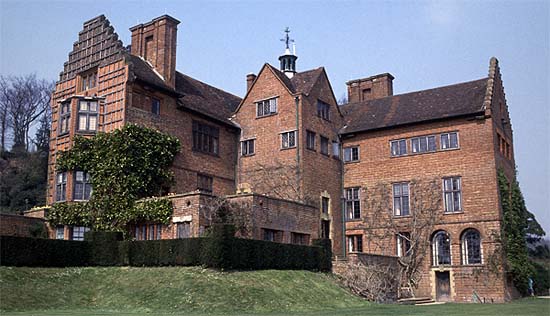Chartwell: Churchill's House of Refuge
by Richard Crowhurst
Winston Churchill is regarded by many as the greatest Englishman
of all time: a great, but flawed, man. He was often,
simultaneously, politician, soldier, writer, historian, artist
and some-time bricklayer. This can be seen in the gardens at
Chartwell, his home of forty years near Westerham in Kent. To
Churchill Chartwell was his refuge, a place visited at his lowest
ebb during the Second World War, and one that he loved as much as
any other in his life. Yet, even as he saw out the later years of
his life, Chartwell belonged to the British nation, ordained to
become 'a shrine to his memory.' Churchill was delighted, and his
spirit inhabits the house to this day.

When Winston Churchill first saw Chartwell in 1922, it was a
modified Elizabethan Manor House, heavily Victorianized and in
need of substantial work. The aspect over the Weald of Kent
initially enchanted both Winston and his wife Clementine.
However, as the costs of refurbishment became apparent,
Clementine's initial enthusiasm turned to resentment. Churchill
commissioned the architect Philip Tilden to help turn Chartwell
into a home and it retains a homely atmosphere to this day. Its
small, almost cramped, corridors and rooms dictate a timed entry
system for visitors and the mish-mash of extensions and
alterations are far from architecturally pleasing. So much work
was undertaken that it was April 1924 before Churchill could
spend his first night there. Work continued on improving the
house and gardens for much of his life.
The house is stuffed with examples of his paintings and drawings.
An expansive visitors book sits in the hall and reads like a
Who's Who of 20th century international and domestic political
history. The library is one of the first rooms and is remarkably
understated given Churchill's literary output. However, this was
a man who had others provide his raw material and facts, and then
moulded them into his own distinctive style. One of the last
rooms on the tour houses an exhibition on Churchill's career.
Two of the highlights of any visit are the dining room and
Churchill's study. The dining room is the family (and public)
heart of Chartwell Manor. It was here, after dinner, that
Churchill would screen films for guests. Large arched windows
offer magnificent views across the terrace to the Garden of
England beyond. It is easy to imagine oneself in a large
conservatory or onboard an ocean liner. This is deliberate:
inspiration came from Churchill's love of trans-Atlantic travel,
in particular the Verandah Grills on Cunard's ships Queen Mary
and Queen Elizabeth. Today National Trust guides are
on hand to help with visitor queries.
The study is upstairs adjacent to Churchill's bedroom. This
allowed him to dictate to his secretaries, one of who was always
on call during the hours of nightfall, from his four-poster bed.
Churchill dictated nearly everything he wrote. When not lying in
bed, he preferred to work standing up and the desk at the side of
the study was specifically designed for this. It was his literary
activity here which sustained him, both mentally and financially,
through the so-called 'wilderness years' of the 1930s. Today the
room is displayed almost as he left it at.
Chartwell is more than just an English Country house. The
gardens, inspired by the Arts and Crafts movement, are
delightful. Between the visitor centre and house, a slope
overlooks a fishpond of huge proportions and woodland glades are
set into the hillside. On the other side of the house,
Churchill's famous wall borders Clementine's rose garden. Those
viewing the wall for the first time are often surprised,
expecting something simple. The local red bricks tower to seven
and eight feet, providing another legacy of Churchill in the 300
acres of grounds.
At the bottom of the garden you can see Churchill's studio just
as he left it. His palette, still covered in paint, lies
alongside his easel and in a small room by the door unfinished
canvasses and completed works are piled to the ceiling.
The house's location is as much a part of Chartwell's attraction
as its famous former resident. The woods and valleys attracted
Churchill originally and in the late forties, when the house was
brought by the nation, he considered being buried here. In a
change of mind typical of the great man he later decided to be
buried in the family church at Blenheim.
Facilities and Information
The restaurant serves a menu inspired by Churchill's favourite
dishes cooked to perfection with local ingredients. There is also
a shop selling a range of Churchill books and souvenirs.
The house is owed and run by The National Trust. Other properties
in the area include Quebec House in nearby Westerham and Emmetts
Gardens.
Related Articles:
- Churchill's Birthplace: Magnificent Blenheim Palace, by Marta Patiño
- https://www.timetravel-britain.com/articles/houses/blenheim.shtml
More Information:
We regret that we no longer have the resources to maintain up-to-date links and/or hours and pricing details for the various sites and attractions listed on this website. For more information about the location(s) listed above, please use your favorite search engine or visit Wikipedia.
Richard Crowhurst is a freelance writer and author based in Lincolshire,
England. He writes on many subjects, including history and heritage topics.
More details can be found on his website, http://www.freelance-writer-and-author.co.uk.
Article and photo © 2006 Richard Crowhurst
|
